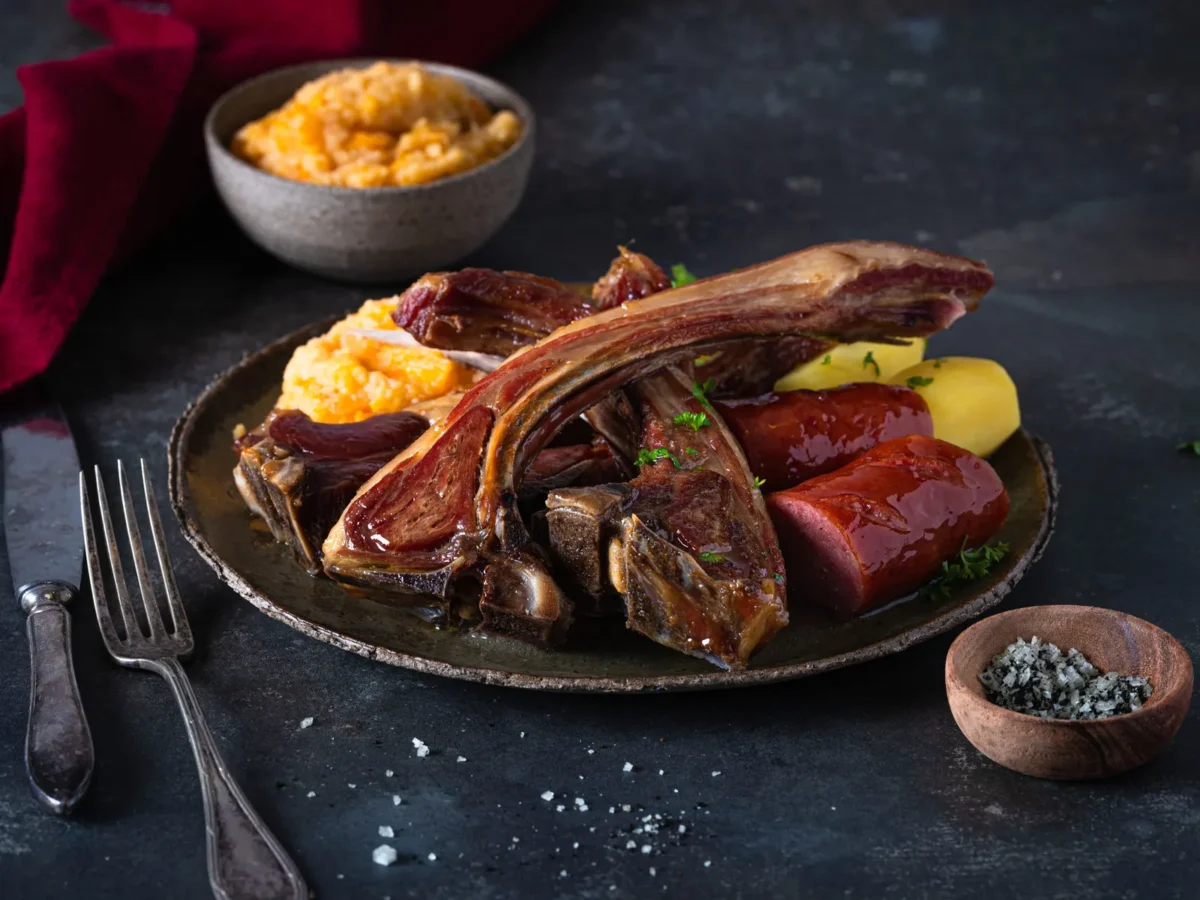Introduction: Norwegian cuisine is known for its rich and flavorful dishes that are deeply rooted in tradition. One such dish is Pinnekjøtt, a beloved delicacy popular across Norway, especially during the holiday season. Made from cured and dried lamb ribs, Pinnekjøtt boasts a unique taste that is both smoky and tender. In this comprehensive guide, we will dive into the origins of Pinnekjøtt, explore its preparation process, discover traditional accompaniments, and provide tips for savoring this delectable Norwegian dish. 1. What is Pinnekjøtt: An Introduction to Traditional Norwegian Cuisine Pinnekjøtt, which translates to “stick meat,” is a traditional Norwegian dish made from lamb ribs. These ribs are cured and dried for several weeks, resulting in tender and flavorful meat. The name “stick meat” comes from the cooking method, where the ribs are steamed on a bed of birch sticks, allowing the meat to become succulent while developing a smoky aroma. This dish is typically enjoyed during festive occasions such as Christmas and New Year’s Eve, bringing families together to savor the flavors of Norway. 2. The History and Origins of Pinnekjøtt: Unveiling the Tradition The origins of Pinnekjøtt can be traced back to the western regions of Norway, where sheep farming has been a vital part of the culture for centuries. The preservation of meat was essential in these cold and mountainous areas, leading to the development of various curing and drying techniques. Pinnekjøtt emerged as a result of this ingenuity, providing a way to store and enjoy lamb throughout the year. Over time, this traditional dish gained popularity across the country, evolving into a symbol of Norwegian culinary heritage. 3. The Ingredients and Preparation of Pinnekjøtt: A Step-by-Step Guide To prepare Pinnekjøtt, you will need high-quality lamb ribs, preferably from a local butcher. The curing process begins by rubbing the meat with a mixture of coarse salt, which helps to draw out excess moisture and aids in preservation. The ribs are then hung in a cool, well-ventilated area for two to three weeks, allowing the meat to dry and develop its distinct flavor. Prior to cooking, the ribs are soaked in water for at least 24 hours to rehydrate and remove excess salt. Once the meat is ready, it is time to steam the Pinnekjøtt. A large pot or steamer is filled with water, and birch sticks are placed at the bottom to elevate the meat. The soaked ribs are arranged on top of the sticks, ensuring they do not come into direct contact with the water. The pot is covered tightly, and the Pinnekjøtt is simmered for several hours, allowing the steam to gently cook the meat, resulting in tender and aromatic ribs. 4. Serving and Sides: Exploring Traditional Accompaniments for Pinnekjøtt Pinnekjøtt is typically served with a variety of traditional accompaniments that complement its flavors. One classic side dish is kålrabistappe, a creamy mash made from boiled rutabaga and potatoes. The combination of the slightly sweet rutabaga and fluffy potatoes enhances the savory taste of Pinnekjøtt. Another popular side is boiled potatoes, which provide a simple and neutral base to appreciate the richness of the meat. Lingonberry sauce, with its sweet and tangy flavor, is often served alongside Pinnekjøtt, adding a refreshing element to each bite. To complete the meal, it is common to serve Tyttebær, a type of cranberry jam, which adds a burst of tartness that balances the richness of Pinnekjøtt. Additionally, flatbread or lefse, a Norwegian soft flatbread, is a common accompaniment, providing a delightful texture and serving as an excellent vessel for enjoying the flavors of Pinnekjøtt. 5. Tips for Enjoying Pinnekjøtt: Embracing the Flavors and Traditions To fully appreciate the flavors of Pinnekjøtt, it is crucial to savor each bite slowly. The meat should be tender enough to easily pull away from the bone. Take time to explore the smoky and salty undertones that make this dish truly unique. Remember to pair it with the suggested side dishes, as the combination of flavors adds depth to the overall dining experience. Embrace the tradition and share this beloved Norwegian dish with friends and family, as Pinnekjøtt’s roots lie not only in the flavors but also in the joy of coming together and celebrating Norwegian culinary heritage. In conclusion, Pinnekjøtt represents the heart and soul of traditional Norwegian cuisine. Its humble origins and rich flavors make it a cherished dish during festive occasions. By understanding its history and carefully preparing and serving this delicacy with traditional accompaniments, one can experience the true essence of Norway. So, gather your loved ones, embark on an epicurean journey, and indulge in the delicious world of Pinnekjøtt!
More Norwegian Christmas Food
Embrace the enchanting Yuletide spirit with a journey through Norway’s Christmas culinary wonders. Our curated category brings you a delectable assortment of festive delights, from traditional main courses to decadent desserts that define the holiday season in Norway. Explore the rich tapestry of flavors and time-honored recipes that make Norwegian Christmas cuisine a true feast for the senses. Let the aromatic allure and cultural significance of these festive dishes transport you to the heart of Scandinavian holiday traditions. Indulge in the joy of Christmas with our handpicked selection of Norwegian Christmas food, where every bite tells a story steeped in tradition and love.








